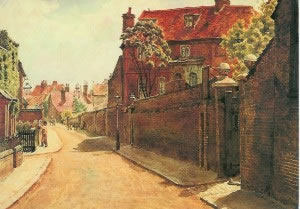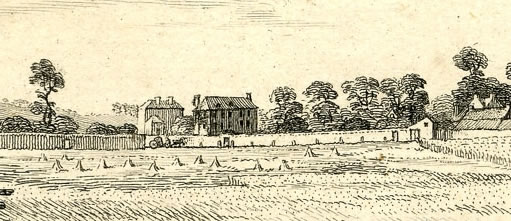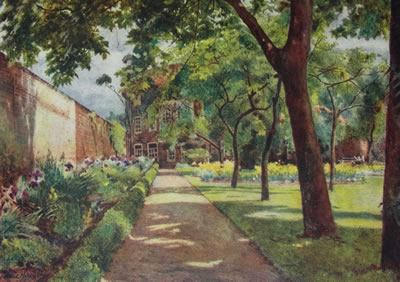Hogarth's House Garden's Rich Past Revealed |
|||||
Val Bott on the history of the walled space outside the house
Stepping through the gate in the wall around Hogarth’s House in Chiswick, you leave behind six lanes of roaring traffic. It really does feel like stepping back into the past, even when planes are flying in every 90 seconds towards Heathrow on a warm summer’s day. The House has just re-opened after a major refurbishment which I have co-ordinated over the last 4 years. Our new presentation of the House attempts to make sense of this place as a home, rather than continuing the past practice of using it as a gallery with serried ranks of Hogarth’s prints in black frames. The Hogarths used it as their second home, away from the noise of Leicester Fields cottage but there are some fascinating residents who came before and after them – and their stories will be told too. It was not, however, part of the plan to refurbish the garden within this project. The double gates at the bottom of the garden have been restored and given back their spherical finials, and the path from there to the House now provides level access from the pavement outside. But replanting and dealing with the sycamore seedlings in neglected areas has to wait for the time being. My research into the garden in the past will help guide appropriate planting in the future. So what do we know? The plot was an orchard, probably from the 1670s. It was enclosed from Chiswick’s Common Field by the Downes family who seems to have been millers and bakers. Susannah Downes left the plot to one of her sons in 1713 and the new house was completed by 1717. In 1749 the Hogarths bought it from the son of the first occupant, Lutheran Pastor Georg Andreas Ruperti. His substantial library was sold over 8 evenings in 1732 and pleasingly included some gardening books. The present garden is a distorted triangle and it was already that shape by the time of the first large scale Ordnance Survey in the 1860s. But on John Rocque’s 1745 Survey of London and Environs, there is clearly a rectangular plot. John Philips, a nephew of Mrs Hogarth and her cousin, Mary Lewis, kept a small collection of Hogarth mementoes and wrote notes to go with them. These items and the notes have found their way into Aberdeen City Art Gallery’s collection. One note reads, ‘In 1759 Mr H increased the size of his garden by taking a lease for 21 years of 264 square foot from the Earl of Morton which made his garden square – The said pce forming two sides of a plain triangle.’ If this was a renewal of a previous lease it may explain the Rocque image for Morton House was next door to the west. [Built by Sir Stephen Fox in 1682-3 Morton House still stood when the property was acquired by the 6th Duke of Devonshire in 1812 in order to extend the grounds of Chiswick House. There he built the conservatory and employed Lewis Kennedy to lay out the Italian Garden; to the north of this three of Fox's four walled gardens survive.] It is not possible to recreate Hogarth’s rectangular garden as later developments – most of them aggressively inappropriate offices and industrial structures for the curtilage of a Grade 1 listed house – crowd up against the walls today. However, there is some evidence that the core of the garden’s structure remains.
Detail from Hogarth's view, his house shown in shade Hogarth’s own sketch of his House, seen from Chiswick Common Field to the north, was published as a print by his widow in 1782. Tall trees seem to follow the far boundary and the western wall of the garden, with lower fruit trees in front of them. The long wall facing the lane with a gate near the House can be seen. At the bottom of the garden (on the right) is a double door giving access to his small carriage house and/or stable with a room above – one of John Phillips’ notes against the print in a scrap book confirms that this was the “paintin room”. The studio was pulled down in the 1870s but a double gate remains here. The Hogarths would have known the old mulberry tree in his garden, and there are stories that Mrs Hogarth made mulberry pies for foundling children who were visiting them. The tree may date from the original orchard; it has survived bomb damage and old age and gave a good crop of fruit this year, some of which was used in small pies at the re-opening of the House. Most houses of this size would have had a vegetable plot growing pot herbs for the kitchen and Hogarth also had a nut walk where he enjoyed playing ninepins with his friends. We know nothing about a flower garden here in the Hogarth’s time. However, Mary Lewis’s brother John, a flautist who was related by marriage to the Clitherows of Boston Manor, lived in The Butts in Brentford. Amongst his neighbours was the Swinden family and it is interesting to imagine that Lewises and Swindens knew each other sufficiently well for Mary Lewis to have bought seeds for her garden at Chiswick from Swinden’s catalogue. We may be able to plant some of his flower garden schemes in the future. When the long connection of Hogarth relatives and friends came to an end in 1813 the House was put up for sale. The newspaper advertisement describes the garden.
Morning Chronicle 29 April 1814 From the mid 19th century the House was occupied by a variety of tenants. In about 1870 a nursery gardener called Coles was working the garden and his family shared the House with Alice Clack, who kept pigs. After Alfred Dawson restored the House in the early 1890s he let it to John Allgrove, described as a florist, who ran the Hogarth’s House Nursery there. Dawson also let to Allgrove part of the garden of his family’s home, The Cedars, which adjoined that of Hogarth’s House to the south. The House was purchased in 1901 by Lieut Col Shipway, who made it his personal project. He took specialist advice from Frederick W Peel, architect, and Austin Dobson, then Hogarth’s most recent biographer. He restored the building, made a collection of Hogarth prints and commissioned chairs and tables based on pieces in Hogarth’s works from the Chiswick Art-Workers’ Guild. He even took the photographs for the 1904 guide book.
Jessie Macgregor's 1913 sketch of the garden The influence of the arts and crafts movement is clear in the garden; having been a nursery garden some replanting must have taken place when Shipway was in charge. The long path from the House to the bottom of the garden was retained (and still survives), and the bed by the wall was planted with purple irises behind a low box hedge. Beneath the mulberry were daffodils – all of this was recorded in the spring of 1913 Jessie Macgregor for her book Gardens of Celebrities and Celebrated Gardens. Val Bott For opening hours and further information: www.hounslow.info/arts/hogarthshouse or ring 020 8994 6757. December 8, 2011 |



